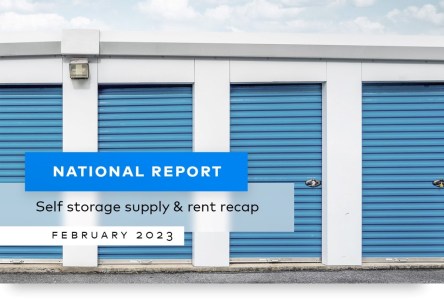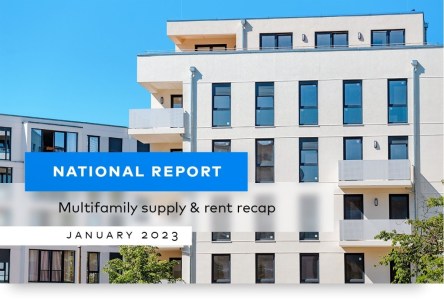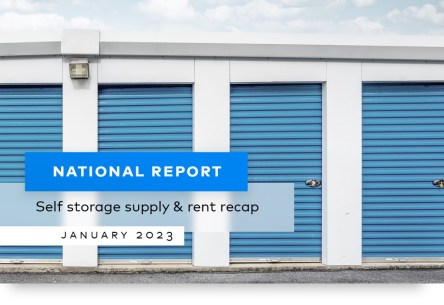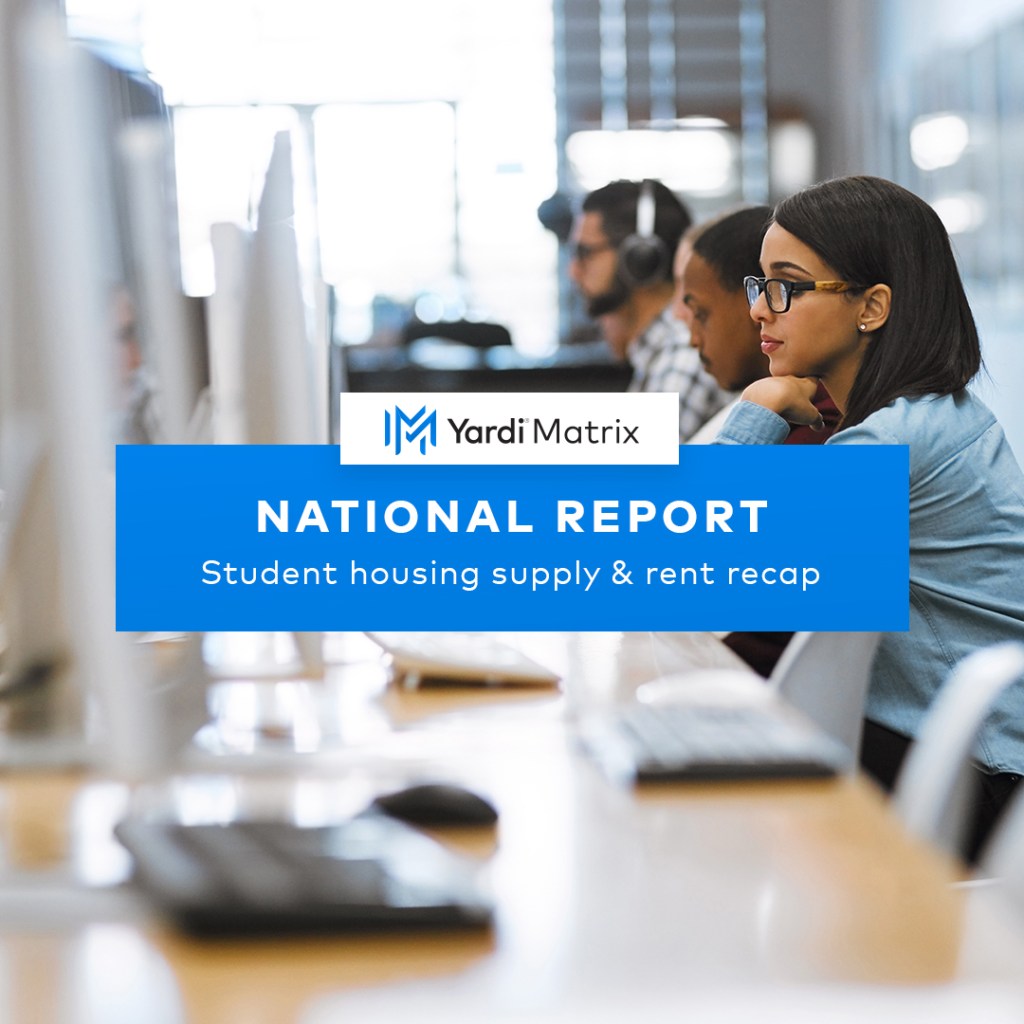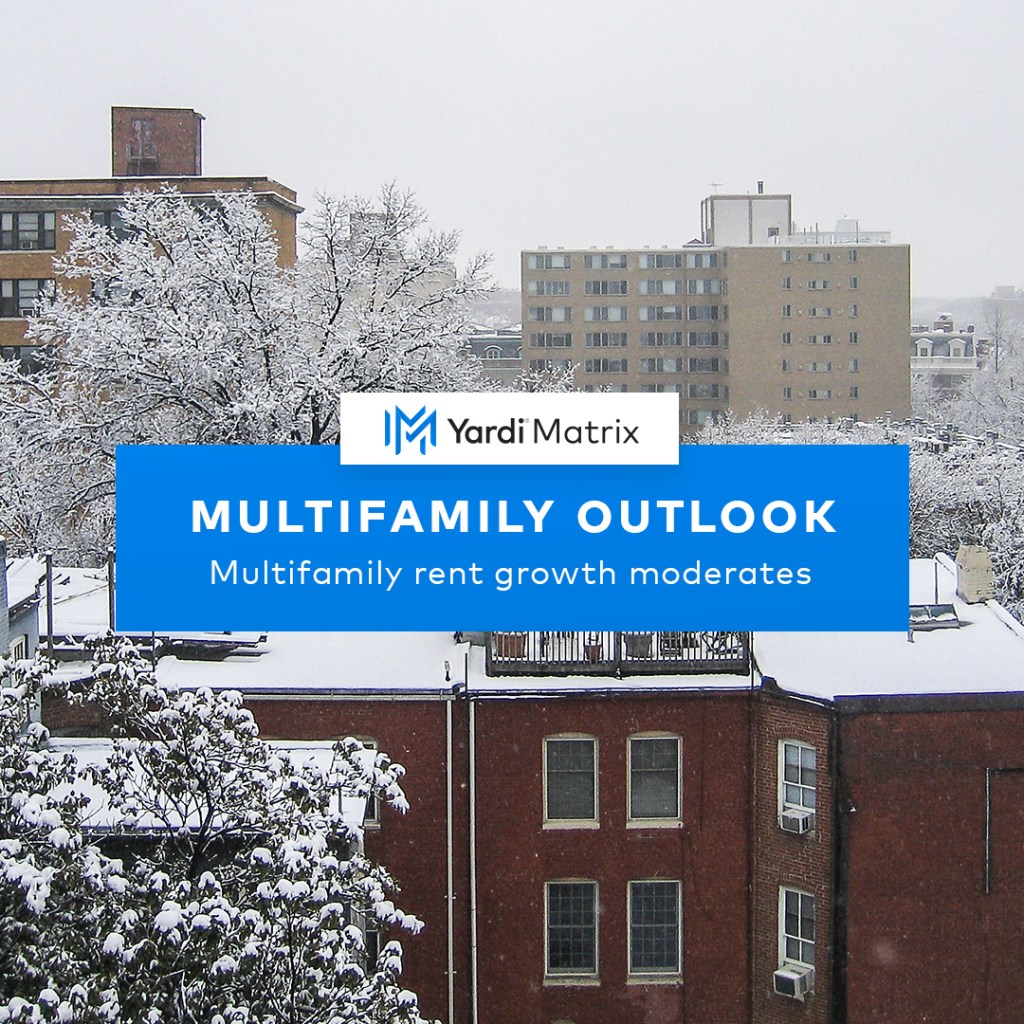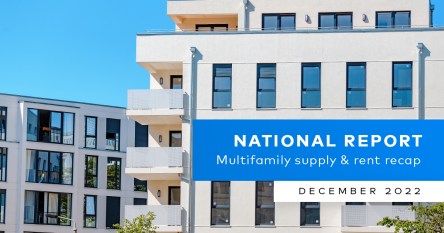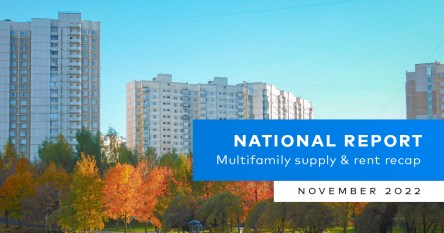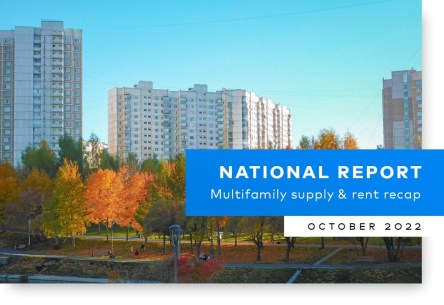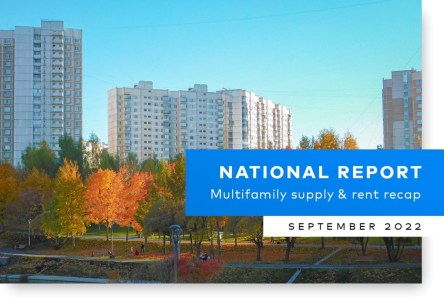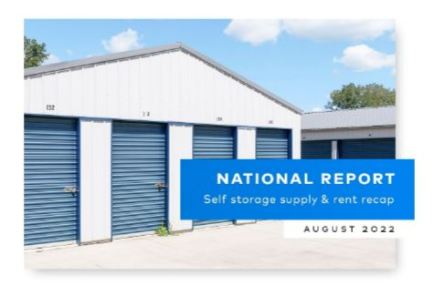Continuing steady demand signals stability for the U.S. self storage sector even as street rates declined in January, according to the February 2023 National Self Storage Report from Yardi Matrix. Year-over-year street rates for 10X10 non-climate-controlled units slid by $7 to $126 in January, a 2.3% drop from their peak of $133 in the summer of 2022. Only five of the top 31 metros tracked by Matrix recorded rate growth in January. Despite this typical seasonal slowdown, “average street rates [for climate-controlled and non-climate-controlled units] remain healthy compared to historical levels,” the report says. The new-supply pipeline increased by 10 basis points month-over-month in January, accounting for 3.7% of completed inventory. In 2022, the number of households using self storage reached 14.5 million, an increase of about 970,000 since 2020. “As a result of the record demand, the self storage sector appears to be well-positioned to withstand potential economic headwinds in 2023,” according to the report. Get the latest on self storage supply, rent trends and more in the new Yardi Matrix report. Get even more details in a webinar on March 1. Yardi Matrix tracks 4,626 self storage properties nationwide in various stages of development. Matrix also maintains operational profiles for 29,072 completed self storage facilities, bringing the total data set to 33,698. Yardi Matrix offers the industry’s most comprehensive market intelligence tool for investment professionals, equity investors, lenders and property managers who underwrite and manage investments in commercial real estate. Yardi Matrix covers multifamily, student housing, industrial, office and self storage property types. Email [email protected], call 480-663-1149 or visit yardimatrix.com to learn...
Rents Hold
Yardi Matrix Market Report
Multifamily rents were flat in January as a strong jobs report indicated that fears of a significant economic recession may be overblown. U.S. asking rents averaged $1,701, unchanged from the prior month, according to the latest Yardi Matrix National Multifamily Report. Continuing late 2022 patterns, year-over-year growth continues to decline, and is now 5.5 percent, down 70 basis points from December. The single-family rental (SFR) market remained strong amid ongoing volatility in home sales. The average U.S. asking rent increased $1 in January to $2,070, while the year-over-year increase fell by 85 basis points to 4.2 percent. “Participants at the late January National Multifamily Housing Council conference in Las Vegas were generally optimistic about demand fundamentals, but concerns centered around issues such as the wave of proposed rent control measures, increasing expenses and high mortgage rates,” say Matrix analysts. However, the creation of 517,000 new jobs in January is a significant bright spot and help ease fears of an imminent economic downturn. The unemployment rate dropped to 3.4 percent last month and wage growth shows no signs of spiraling. “Concerns about a hard-landing recession that would reduce household formation are being alleviated by the continuing stellar performance of the job market,” states the report. Gain more insights by downloading January’s Multifamily Report. Last year, U.S. multifamily rents increased by 6.4 percent after peaking near 16 percent in 2021, according to Yardi Matrix. Those were record figures, the highest seen in a century. The 2023 Yardi Matrix Multifamily Outlook expects that rent growth will be closer to its historical average in 2023. Yardi Matrix offers the industry’s most comprehensive market intelligence tool for investment professionals, equity investors, lenders and property managers who underwrite and manage investments in commercial real estate. Yardi Matrix covers multifamily, student housing,...
Walkable Urbanism Rankings
Yardi Matrix Contributes Data
The nation’s top 35 metros are ranked on walkable urbanism using a newly released index that considers commercial rent premiums, multifamily rents, and for-sale home prices. For the first time, Yardi Matrix was a significant source of data for the report, which was co-authored by Michael Rodriguez, AICP, and Christopher B. Leinberger; and ultimately concludes that the demand for walkable urban real estate far exceeds supply. “Foot Traffic Ahead: Ranking Walkable Urbanism in America’s Largest Metros” finds that the top cities for walkability are: New York City Boston Washington, DC Seattle Portland San Francisco Chicago Los Angeles The rankings are based on the share of office, retail, and rental multi-family occupied square footage in walkable urban places relative to the metro region as a whole. “(The report) finds higher demand driving premiums for commercial and multifamily rents and for-sale home prices in walkable urban places, compared to car-dependent alternatives,” its authors conclude. According to Smart Growth America, the 2023 report required a different approach in methodology and analytics than in past years. That’s attributed to the pandemic. “Since the 2019 report, much of urban life has changed: the popularity of remote work skyrocketed; ever-increasing housing demand continued to push up the price of homes; public parks became invaluable social gathering spaces; and streets that once served only cars were shut down to make way for people,” SGA stated. “Taking these changes into account, FTA takes stock of the nation’s 35 largest metropolitan areas to identify how walkability in these places has transformed.” Among the interesting data points from the report: – Small spaces, significant population: Researchers found that 19.1 percent of the total U.S. real GDP and 6.8 percent of the U.S. population are located in walkable urban places that represent just 1.2 percent of total landmass of the top 35 U.S. metros. – Societal benefits: Walkable urban areas have the potential to improve community health by promoting physical activity, can reduce emissions by decreasing car use, and can advance equity via access to economic opportunity. –A mix of real estate product: Walkable urban places contain the highest concentration of office space (42.1 percent), just over one-third of multifamily rental spaces (30.4 percent), just under a quarter of retail space, and the smallest amount of for-sale housing (11.6 percent). –Lack of walkable urbanism creates community challenges: The report’s authors find that a walk of walkable places is directly connected to the U.S. affordable housing and cost of living crisis. “Housing in the very locations where it is most needed—such as transit-served and infill locations— remains challenging to deliver on account of restrictive zoning, lending policy, and pandemic-era supply chain and labor issues,” states the report. Check out the downloadable Foot Traffic Ahead report for more insights, and read additional coverage of the report and its impact on multifamily real estate from Multihousing...
Self Storage
Sees Seasonal Slowdown
National self storage street rates for all unit types continued to decline in December as the demand for housing dropped and seasonal trends took effect, according to the latest Yardi Matrix National Self Storage Report. National street rates for 10×10 non-climate-controlled (NON CC) units decreased 2.3 percent year-over-year in December to $126, a $7 drop from their summer peak. Rates for similar-size climate-controlled (CC) units fared slightly worse, dropping 3.4 percent year-over-year to $142, a $10 drop from the summer high. The decline in street rates in the last half of 2022 was expected due to normal seasonal slowdowns in demand, and overall rates remain healthy compared to historical levels. “Self storage had a strong year and is well-positioned heading into 2023. Street rates have declined, but operators have focused on increasing existing customer rents to achieve strong revenue growth, outweighing the rise in operating costs,” say Matrix experts. According to market research, operators remain confident in the resilient demand created over the past two years and the ability to backfill occupancy in the spring with higher-paying new customers. “A rapid rise in development costs, including the cost of debt, will also likely cause a deceleration in new supply in coming years, another positive for owners,” states the report. Learn more about the state of the self storage market nationwide. Yardi Matrix tracks a total of 4,627 self storage properties nationwide in various stages of development — including 1,789 planned, 812 under construction and 669 prospective properties. Matrix also maintains operational profiles for 29,032 completed self storage facilities across the United States, bringing the total data set to 33,659. Yardi Matrix offers the industry’s most comprehensive market intelligence tool for investment professionals, equity investors, lenders and property managers who underwrite and manage investments in commercial...
Student Housing
Expected to Outperform Again
The student housing industry is set up for another solid performance in 2023 after record returns last year, according to the latest National Student Housing Report from Yardi Matrix. “Momentum is strong heading into the new year, even as the effect of higher interest rates takes hold in the economy and has led multifamily rents to decelerate,” say Matrix experts. “Student housing remains largely unaffected, as the industry typically does better during times of economic volatility.” As of December 2022, 48 percent of beds at Yardi 200 universities were already leased for the fall 2023 school year, representing a new record high for this time of year. Rent growth also remained strong, at 4.7 percent annual growth. “With over eight months to go until the start of the next school year, we anticipate 2023 being another record-breaking year for student housing performance,” states the report. One caveat: highly selective universities with name recognition are maintaining their interest among incoming students, while smaller schools are having more difficulty with enrollment. The slowing economy is having an impact on new student housing supply. With interest rates increasing, the development pipeline is contracting. The development pipeline for Yardi 200 universities (including planned, prospective and under-construction properties) decreased by over 3,000 bedrooms from December to January, representing a 2.6 percent contraction. Gain more insight in the new National Student Housing Report. The student housing data set includes over 2,000 universities and colleges nationwide, including the top 200 investment grade universities across all major collegiate conferences. Known as the “Yardi 200,” it includes all Power 5 conferences as well as Carnegie R1 and R2 universities. Yardi Matrix covers multifamily, student housing, industrial, office and self storage property types. Email [email protected], call (480) 663-1149 or visit yardimatrix.com to learn...
Multifamily Outlook
From Yardi Matrix
Multifamily rent growth began to slow in late 2022 as economic pressures, including the impact of inflation, took root. The 2023 Multifamily Outlook from Yardi Matrix expects that rent growth will be closer to its historical average in 2023. Last year, U.S. rents increased by 6.4 percent after peaking near 16 percent in 2021, according to Yardi Matrix. Those were record figures, the highest seen in a century. The 2022 increase is expected to drop by half this year. “All eyes are on interest rates and how quickly inflation recedes. Economic growth will likely wane in the second half as the impact of rapid rate hikes take effect,” states the outlook. “This year we foresee rent growth dropping in half to 3.1 percent as demand lessens and deliveries remain high.” Demand is decreasing due to less renter migration, a dip in new household formation and declining affordability. Meanwhile new units are coming online nationwide. The forecast calls for 440,000 new deliveries in 2023, a stock increase of 2.9 percent. Deliveries will be concentrated in fast-growing markets, including Dallas, Austin, Charlotte, Nashville and Orlando. However, starts are expected to decline due to rising construction costs, a shortage of construction workers and planning/permitting delays. Gain more insights on the industry in the full report. Yardi Matrix offers the industry’s most comprehensive market intelligence tool for investment professionals, equity investors, lenders and property managers who underwrite and manage investments in commercial real estate. Yardi Matrix covers multifamily, student housing, industrial, office and self storage property types. Email [email protected], call (480) 663-1149 or visit yardimatrix.com to learn...
Asking Rents Fall
Multifamily Update
Multifamily asking rents recorded historic highs in 2022 but began to move south as the year concluded, recording another $4 drop to a national average $1,715 in December, according to the latest Yardi® Matrix National Multifamily Report. Year-over-year growth declined by 80 basis points to 6.2 percent last month, the lowest level since May 2021. Over the year, national asking rents recorded a 6.2 percent uptick, the second-highest annual growth in 100 years after 2021’s nearly 15 percent increase. But as the economy cooled in the fall and demand decreased, rents fell 0.2 percent in December and 0.6 percent in the fourth quarter. The single-family rental (SFR) market is also seeing slowing. National asking rates increased 4.8 percent year-over-year in December, which was a decrease of 100 basis points from November. SFR rents dropped by $8 to average $2,083 last month. “With a variety of concerns about the economy and affordability, we expect rent growth in 2023 will be closer to typical levels,” states the latest report. In 2023, Yardi Matrix expects asking rents should remain flat or fall slightly through the spring, when growth is normally strongest. Then rents will likely rise moderately, though nowhere near the dramatic levels of the last two years. Learn more in the latest Matrix National Multifamily Report. Yardi Matrix offers the industry’s most comprehensive market intelligence tool for investment professionals, equity investors, lenders and property managers who underwrite and manage investments in commercial real estate. Yardi Matrix covers multifamily, student housing, industrial, office and self storage property types. Email [email protected], call (480) 663-1149 or visit yardimatrix.com to learn...
Rents Drop
Yardi Matrix Multifamily Update
The anticipated slowdown in multifamily performance arrived last month, as the sector clocked its lowest year-over-year growth since mid-2021, according to the latest Yardi® Matrix National Multifamily Report. U.S. asking rents fell $9 during the month to $1,719, while year-over-year growth dropped to seven percent, the lowest level in 17 months. The decreases are attributed to economic headwinds and deteriorating demand. The $9 rollback was the largest one-month decline in rents in over a decade. The deterioration in rents was not unexpected. Rent increases have far exceeded normal growth patterns for nearly two years. Average asking rents increased by 22 percent nationally between January 2021 and October 2022, a rate that would be unsustainable under optimal conditions. “With the economy softening, demand for units slowing and rising interest rates creating head- winds for housing, multifamily asking rent growth finally took a turn downward in November,” states the report. “The decades-high inflation rate has left household balance sheets in a weaker position than a year ago, while economic growth is slowing as the Federal Reserve raises interest rates.” Absorption of apartments has been positive in 2022, but well below 2021 levels that were boosted by strong job growth and household savings coming out of the pandemic. Average U.S. rents are up 6.4 percent year-to-date, and the national occupancy rate, while slipping in recent months, is a healthy 95.6 percent. And while rent growth has turned negative in many metros this fall, every one of Matrix’s top 30 metros maintains positive year-over-year growth. The single-family rental market is also declining. The average U.S. asking rent dropped $5 in November to $2,091, while the year-over-year increase fell by 80 basis points to 5.9 percent. Learn more in the latest Matrix National Multifamily Report. Yardi Matrix offers the industry’s...
Yardi Matrix Multifamily Webinar
Sector outlook, anticipated recession and more
Yardi Matrix experts Jeff Adler and Paul Fiorilla presented their final 2022 outlook for the multifamily sector during a Nov. 16 webinar. As with most current economic forecasts, it’s a challenging picture despite recent record-setting performance and consistently strong fundamentals. The presentation materials and webinar recording are now available for download. According to the latest National Multifamily Report, average multifamily asking rents showed a slight increase in October, despite weaker demand and dipping year-over-year (YOY) growth. “The pandemic recovery has been rapid, it has been V-shaped, but now it is indeed cooling. We’re really on the downturn, is what I would tell you. The U.S. economy is slowing, the yield curve has inverted for all intents and purposes,” said Adler, vice president of Yardi Matrix. “When it comes to the U.S. multifamily industry, the domestic migration has had a significant impact on demand, but household formations have had even a larger impact,” Adler said. Demographic trends are expected to support continued housing demand. Rising interest rates, however, will preclude many would-be buyers from home purchases in the near future. First-time homebuyers are being frozen out of the market, according to the National Association of Realtors, and will be more likely to remain in rentals. “The capital markets are really what’s the problem, mortgage rates are up to 6 percent and above, and valuations have adjusted downward,” said Adler, off as much as 25 percent from a peak in January 2022. However, U.S. multifamily continues to be a standout sector among all asset types. “Declining homeownership will be a bit of a tailwind (for multifamily),” as long as household formation holds up, Adler said. “Fundamentals have been great, but they are decelerating.” U.S. asking rents increased $3 in October to $1,727. Year-over-year growth fell to 8.2 percent, the lowest level since the summer of 2021 and down from its 15.3 percent peak in the first quarter. The single-family rental market is also cooling off. The average U.S. asking rent was unchanged at $2,088 in October, while the YOY increase fell by 160 basis points to 6.6 percent. “SFR/BTR fundamentals are strong, but they’re also decelerating, very similar to multifamily,” Adler said. And with a difficult construction financing environment, limited new supply is expected through 2026. This could exacerbate the U.S. housing supply shortage, pushing it out through the next decade. As far as an anticipated recession, that’s currently very likely by the fourth quarter of 2023, according to experts. “Essentially we’re on a glide path to the next recession, which is probably one of the most well forecasted recessions I’ve seen in a while,” Adler observed. Learn more about Yardi Matrix’ wide variety of commercial real estate reports and...
Self Storage Update
From Yardi Matrix
National self storage street rates hit their lowest average of the year last month, according to the latest National Self Storage Report from Yardi Matrix. Average street rates for both 10X10 climate controlled (CC) and 10X10 non-climate controlled (NON-CC) units slipped in October for the second straight month as demand weakened. The national average rate in October was $145, the lowest in 2022 so far. The figure is a 0.7 percent decrease year-over-year (YOY). “Home sales, a major driver of storage demand, have slowed sharply in recent months as rising mortgage rates have made homebuying less affordable,” states the report. “What’s more, as inflation persists and a recession is increasingly likely, households are cutting expenditures on non-essential items such as storage.” Many operators are reducing street rates to maintain high levels of occupancy and looking for ways to cut costs in the event of an anticipated recession. Some operators are moving to remote facility management to reduce site staff and cut operating costs. For NON-CC units, only one of the top 31 Matrix-tracked metros had an annual street rate increase greater than five percent in October, while rates decreased in 11 of the top metros. For CC units, just one of the top 31 had five percent or more growth, while 21 metros registered negative rate growth YOY. Learn more about the state of the self storage market nationwide. Yardi Matrix tracks a total of 4,458 self storage properties nationwide in various stages of development — including 1,711 planned, 800 under construction and 604 prospective properties. Matrix also maintains operational profiles for 28,847 completed self storage facilities across the United States, bringing the total data set to 33,305. Yardi Matrix offers the industry’s most comprehensive market intelligence tool for investment professionals, equity investors, lenders and...
Multifamily Update
From Yardi Matrix
Average multifamily asking rents showed a slight increase in October, despite weaker demand and dipping year-over-year (YOY) growth, according to the latest Yardi® Matrix National Multifamily Report. U.S. asking rents increased $3 in October to $1,727. Year-over-year growth fell to 8.2 percent, the lowest level since the summer of 2021 and down from its 15.3 percent peak in the first quarter. The single-family rental market is also cooling from record-level performance. The average U.S. asking rent was unchanged at $2,088 in October, while the YOY increase fell by 160 basis points to 6.6 percent. The deceleration in asking rents is gradual, as all of the Matrix top 30 metros produced YOY rent increases. Experts are concerned about how the multifamily market will react to the rapid increase in short-term interest rates as the Federal Reserve attempts to reduce inflation. “The inevitable economic slowdown raises questions about when the impact will start to be felt and how much the sector will be affected,” states the report. “Demand has weakened since the first quarter due to slowing job growth and concerns over the macroeconomic environment. The robust household formation that drove demand in 2021 is no longer in effect.” The U.S. rental occupancy rate has dropped 50 basis points over the past year, but the national 95.5 percent rate remains above the long-term average. With debt costs higher and still rising, property sales and new construction have begun to slow. However, with home mortgage rates up to 7.3 percent as of early November, first-time homebuyers are being frozen out of the market, according to the National Association of Realtors, and will be more likely to remain in rentals. Learn more in the latest Matrix National Multifamily Report. Yardi Matrix offers the industry’s most comprehensive market intelligence tool...
Self Storage Slows
Yardi Matrix Reports
Year-over-year national street rates continued to tick up slightly in September, but month-over-month gains are now declining, according to the latest National Self Storage Report from Yardi Matrix. However, revenue growth remains strong as operators focus on boosting renewal rates. National street rates for 10×10 non-climate-controlled (NON CC) units increased 0.8 percent year-over-year in September, while rates for similar-sized climate-controlled (CC) units remained flat. The overall average street rate was up 0.7 percent, which is the slowest rate of annual growth for this category since July 2020. The national average rate for 10×10 NON CC units fell to $148 in September, not far below the all-time high of $152 reached in July. While the national average rate for similar-sized CC units dropped to $131, that figure was only $2 short of the record set this summer. Metros in the Southeast and Southwest continue to fare the best. For 10×10 NON CC units, only three of the top 31 Matrix-tracked self storage metros had street rate increases greater than five percent in September, while rates decreased in nine. For 10×10 CC units, none of the top 31 had five percent or more growth, while 13 metros experienced negative rate growth year-over-year. Learn more about the state of the self storage market nationwide. Yardi Matrix tracks a total of 4,306 self storage properties nationwide in various stages of development — including 1,649 planned, 769 under construction and 548 prospective properties. Matrix also maintains operational profiles for 28,798 completed self storage facilities across the United States, bringing the total data set to 33,104. Yardi Matrix offers the industry’s most comprehensive market intelligence tool for investment professionals, equity investors, lenders and property managers who underwrite and manage investments in commercial real estate. Yardi Matrix covers multifamily, student housing, industrial,...
Student Housing Earns High Marks
Record setting performance in 2022
The Yardi Matrix team continues to be bullish on the student housing sector following another stellar quarter of performance in Q3 2022. Jeff Adler, vice president of Yardi Matrix, delivered a glowing report card for student housing during a webinar last week. You can listen to the full recording here. “The sector is a great place to be over the next several years,” Adler said. “If you look across the entire landscape of asset types, student housing is extremely well positioned with exceptional offensive characteristics, as well as this gap between multifamily and student housing rents.” The gap means that there is a meaningful opportunity for additional student housing rent growth, particularly in urban markets, Adler explained. Multifamily rents jumped during the pandemic recovery, while student housing rent increases have not been as steep. According to the latest National Student Housing report: “The impact of multifamily rent trends on student housing will be stronger in university areas with a prominent shadow market, given the availability of options within a close radius.” Key highlights from Q3 performance include: Record-preleasing in advance of the 2022/23 school year, at 96.6 percent which was 2.3 percent higher than last yearPer-bedroom rents are 4.1 percent higher than a year ago, averaging $789 as of Sept. 2022Top tier universities received a surge in applicant interest and enrollment; however, less selective schools are struggling and there is an overall decrease in total students enrolledDeliveries of new student housing properties surged in 2022 These data points and many more are found in the new quarterly National Student Housing Report. The pace of preleasing was faster for selective universities with higher enrollment. But positive performance was widespread among university types across the country. Twelve universities had double-digit growth in pre-leasing levels in September compared to 2021, with Washington State University (18.9 percent growth) and the University of Houston (16.4 percent) topping the list. At some popular schools with growing enrollments, available student housing supply hasn’t been sufficient to house the incoming class. A problem that used to be unique to California schools has now become more widespread. Elevated investment activity continues despite rising interest rates, and the new-supply pipeline is robust. Nearly 45,000 new student housing bedrooms were delivered in 2022, accounting for 5.3 percent of Yardi Matrix-tracked housing stock. Matrix tracks 1.17 million off-campus student housing bedrooms at 2,065 properties across the...
Stalled Rents
But Sound Fundamentals
“Key fundamentals remain strong” in the U.S. multifamily amid a flattening of average asking rents in September, according to a new national multifamily report from Yardi® Matrix. The $1,718 rate, unchanged from August, reflects the impact of the economic slowdown and Fed interest rate hikes. Year-over-year rent growth slid more than a full percentage point for the third month in a row, bringing it below 10% for the first time since July 2021. National asking rents remain at record highs and occupancy rates holding steady at around 96% since June 2021, although “the market may be coming to an end of its extraordinary run of rent growth,” the report says. Average national asking rents in the single-family rental segment fell by $7 to $2,081 in September, the second consecutive month of decline, while year-over-year growth fell 170 basis points to 7.8%. The sector’s outlook remains robust, the report says, because many prospective homebuyers who are priced out of the market turn to single-family rentals. Read the full report for insight into the impact of supply, demand, demographics, employment, migration and more on the multifamily market. The September report includes two new features – lease renewal percentages and renewal rent growth, and rent-to-income ratios – that will be included in future monthly reports. Yardi Matrix offers the industry’s most comprehensive market intelligence tool for investment professionals, equity investors, lenders and property managers who underwrite and manage investments in commercial real estate. Yardi Matrix covers multifamily, student housing, industrial, office and self storage property types. Email [email protected], call (480) 663-1149 or visit yardimatrix.com to learn...
Rates Slow
For Self Storage
Average self storage street rates reduced slightly in August, according to the latest National Self Storage Report from Yardi Matrix. A national average overall street rate of $149 was recorded. Despite moderating street rate performance, demand continues to be strong. The new self storage report focuses on areas of demand for storage units, which include apartment renters and Gen X (late 30s to 50s) customers. “Gen Xers are among the biggest users of storage, with 44 percent reporting use of storage units and 21 percent planning to use it in the near future. But even as an increasing number of households use self storage, we expect to see further moderation of street rates the rest of this year,” states the report. Storage owners remain focused on growing rents of existing customers, relying on demand for the service that grew significantly in 2021. Secondary markets experiencing rapid population growth continue to lead in street rate gains. For 10×10 non-climate-controlled (NON CC) units, eight of the top 31 metros had street rate increases greater than five percent in August, while rates decreased in seven metros. Year-over-year street rate growth continues to decelerate. Nationwide, the overall average street rate, which includes all unit sizes and types, grew 1.4 percent year-over-year in August, a 130-basis-point drop from July’s annual growth rate and a 280-basis-point drop from the rate in June. Learn more about the state of the self storage market nationwide. Yardi Matrix tracks a total of 4,203 self storage properties nationwide in various stages of development — including 1,594 planned, 760 under construction and 515 prospective properties. Matrix also maintains operational profiles for 28,719 completed self storage facilities across the United States, bringing the total data set to 32,922. Yardi Matrix offers the industry’s most comprehensive market intelligence...
Multifamily Rents Drop
According to Yardi Matrix
Average apartment asking rents decreased for the first time in 2022, dropping by $1 to $1,718, according to the latest Yardi Matrix Multifamily Report. The anticipated slowdown is no surprise to analysts, who observe in the new report that the U.S. economy is starting to feel the effects of higher interest rates, while migration is slowing and affordability is affecting high-growth metros. “Rent growth tends to slow in the fall, but this year comes at the tail end of the unprecedented increases. The deceleration in August was strongest in many of the markets that have had the most growth over the past two years, a sign that affordability is becoming an issue,” states the report. It’s possible that deceleration could continue for the remainder of the year. Markets that have had the most growth over the past two years are seeing the strongest signs of affordability issues. Year-over-year rent growth dropped 7 to 8 percentage points over the last two months in Orlando (16.9 percent in August), Miami (16.7 percent) and Tampa (14 percent). The cooling housing market is a positive demand driver for multifamily, but inflation and a slowing job market are eroding residents’ ability to pay. Rent declines were concentrated in high-end Life- style properties. Lifestyle rent growth was negative in 21 of Yardi Matrix’s Top 30 metros. Overall, year-over-year growth decelerated by 170 basis points to 10.9 percent. Nationally, asking rents are up 6.6 percent year-to-date, higher than any year prior to 2021. The U.S. occupancy rate was steady at 96 percent. The single-family sector continues to mirror the activity in multifamily. The average single-family asking rent decreased by $2 in August to $2,090, while year-over-year growth dropped by 170 basis points to 9.5 percent. Learn more about the changing outlook for multifamily in the latest multifamily report. Yardi Matrix offers the industry’s most comprehensive market intelligence tool for investment professionals, equity investors, lenders and property managers who underwrite and manage investments in commercial real estate. Yardi Matrix covers multifamily, student housing, industrial, office and self storage property types. Email [email protected], call (480) 663-1149 or visit yardimatrix.com to learn...
RV/Boat Storage
A Growth Market
Consumer purchases of recreational vehicles and boats are spurring strong demand for storage facilities, creating investment opportunities within this niche asset class, according to a new research bulletin from Yardi Matrix. The bulletin outlines factors driving demand for RV and boat storage. Most notable among them are a record number of acquisitions. In 2021, 571,000 RV registrations and 313,000 boat sales were recorded, driven largely by consumers’ desire for outdoor vacation activities during the pandemic and a shortage of space in residential areas to store the vehicles. RV/boat storage facility deliveries are expected to rise to the highest levels in nearly two decades in 2022, the bulletin reports. However, this growth, constrained by the limited number of developers and suitable facilities, zoning issues and other factors, is not fully meeting demand. Sixty-six property sales valued at $284.5 million took place in 2021. With the average price per acre already 40% higher in 2022 over last year, this year “will likely be another record year for RV/boat storage transaction volume,” the bulletin says. Although vehicle sales could be slowed by rising interest rates, supply chain snags and a slowing economy, “growth in the total number of RVs and boats to be delivered over the next five to 10 years is likely to be solid and increase demand for storage,” the bulletin says. Read the research bulletin to learn more about the RV/boat market’s current state and prospects and why this subsector of the self storage vertical presents an opportunity for investors. Yardi Matrix offers the industry’s most comprehensive market intelligence tool for investment professionals, equity investors, lenders and property managers who underwrite and manage investments in commercial real estate. Yardi Matrix covers multifamily, student housing, industrial, office and self storage property types. Email [email protected], call...
Self Storage Moderates
But Outlook Still Positive
Economic stressors and cranky consumers were a focus of the latest Yardi Matrix webinar, where Jeff Adler, vice president of Yardi Matrix, focused on the self storage market as well as presented a macro-economic outlook and honed in on the storage market for RVs and boats. The economic recovery from the pandemic essentially complete, return to normal doesn’t necessarily mean a rosy forecast for businesses hoping to keep growing. Adler predicted that a recession is definitely on the horizon by 2024. “The Fed is in a tightening cycle; they will continue to increase (interest) rates until they see clear evidence of decreasing inflation back to trend. Their goal is two percent. It’s very hard to get to that level given all of the stressors in the economy,” Adler stated. Those stressors include rising housing rents, which have created affordability issues in some markets; the labor market, which continues to be tight as 3-4 million workers have left the workforce; and inflation, a major source of stress for consumers. In August, multifamily asking rents dropped for the first time in 2022. The decrease was only by $1, but markets that saw the most heated growth during the pandemic, like Florida cities Orlando, Miami and Tampa, took harder hits. “You have a cranky consumer base facing all these stressors,” said Adler. Ongoing interest rate hikes are unlikely to buoy their spirits. Some gas price relief has helped a bit, though prices are still much higher than normal in many states. For the self storage sector, an outlier among real estate sectors with continually impressive performance throughout the pandemic, rents have finally stopped growing just in the last couple of months. Average U.S. street rates for 10X10 non-climate-controlled (NON CC) units remained at $132 in July, matching the all-time high set in June. “Self storage growth is moderating, and you can see it in street rate growth which has come down now sequentially,” Adler said. “There are some markets that are beginning to decline. Their occupancy is retreating which would tell us that the demand wave is also receding.” Major markets with the strongest recent self storage rate growth include Atlanta, Orlando, Miami and Tampa. Those that are seeing the largest asking rate declines are Portland, Philadelphia and Washington, D.C. Investment in the sector, which was historic in 2021, has now tempered. “From an equity standpoint, storage just crushed it in 2021, from a public REITs perspective. It has pulled back some in 2022, as one would expect. But it’s still performing quite well,” Adler said. Typical occupancy rates for storage in the 80-percentile range indicated robust performance. In the last two years, many markets have seen occupancy rates in the 90-percentile range. The webinar also covered trends in the niche storage area of RV and boat storage, which Adler will speak on this week at the annual Self Storage Association Fall conference in Las Vegas. Storing RV and boats accounts for three to five percent of the total storage market. “Demand has been surging, both because of the growing use of RVs and boats, and it’s hard to build (these facilities) in residential areas. The aging of the population means more people are buying these things,” Adler said. “I do think this is an interesting niche that’s earlier in development than existing consumer self-storage and that makes it an interesting opportunity for early-stage investors.” Learn more about the economic outlook, state of the self storage industry across the nation, and RV/boat storage investment opportunities in the Yardi Matrix webinar...
Storage Stays Steady
Rents Remain at Historic Highs
Demand for self storage units is steady, so street rates remained at record highs last month, according to the latest National Self Storage Report from Yardi Matrix. Average U.S. street rates for 10X10 non-climate-controlled (NON CC) units remained at $132 in June, matching the all-time high set last month. Climate controlled (CC) 10×10 units were an average of $151, also an all time high. The latest rates signal an expected slowdown in growth. Nationwide, the overall average street rate, which includes all unit sizes and types, grew 2.1 percent year-over-year in July, a 210-basis-point drop compared to June’s annual rate growth. “With strong demand and street rates at all-time highs, storage operators have more opportunity to increase rents for existing customers and replace rate-sensitive existing customers with new customers at the elevated street rates,” say Matrix analysts. During recent second-quarter earnings calls, several REIT executives said they expect seasonality to return in 2022’s second half after several quarters of unusually low move-outs. The number of customers moving out is likely to normalize later this year. While street rates are shrinking in some areas of the country, growth remains the healthiest in the Southeast. For 10×10 NON CC units, nine of the top 31 metros had street rate increases greater than five percent in July, while rates decreased in four. For 10×10 CC units, only two of the top 31 had five percent or more growth, while eight experienced negative growth. Learn more about the state of the self storage market nationwide and sign up for an Aug. 31 webinar on the vertical, where Matrix experts will go in-depth on storage trends and the economy overall. Yardi Matrix tracks a total of 4,156 self storage properties nationwide in various stages of development — including 1,555...
SFR/BTR Assets Attract Investment
Development also on the rise
Institutional investment in rental single family rental (SFR) homes is on the rise and expected to grow dramatically over the next eight years, according to a new bulletin on the sector released today by Yardi® Matrix. However, rising interest rates are forcing investors to reassess the most effective strategies for growing portfolios and may contribute to lower near-term returns. Institutions have committed more than $60 billion to buying single-family homes over the past year, according to various corporate announcements and news articles. Recent research by MetLife Investment Management (MIM) estimated that institutions own some 700,000 single-family rentals in 2022, about 5 percent of the 14 million SFRs nationally. MIM forecasts that by 2030, institutions will increase SFR holdings to 7.6 million homes, more than 40 percent of all SFRs. Institutional acquisitions of SFRs in communities of 50 or more units soared in 2021 to $2.5 billion, according to Yardi Matrix. Institutional portfolio growth is currently focused on build-to-rent (BTR) projects or acquiring portfolios from smaller owners. BTRs are on track to deliver far more units in 2022 than in any previous year. More than 25,000 units are under construction and nearly 4,300 were already delivered in the first half of 2022, meaning the industry will easily surpass 2021’s record-high 7,705 deliveries. “Rising home and mortgage costs in the second quarter of 2022 increased the cost of capital for institutional buyers, so the segment’s growth is likely to slow and returns will moderate. Even so, the industry benefits from strong long-term demand drivers and the explosive growth in institutional capital,” say Matrix analysts. Get more insight into investment activity, development and rent trends for the SFR/BTR sector in the new Yardi Matrix...

